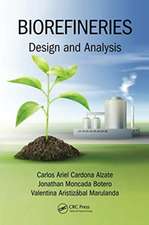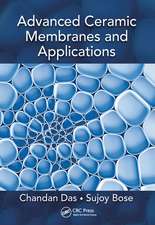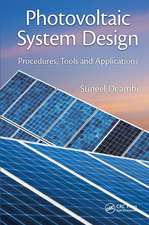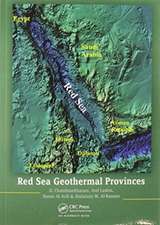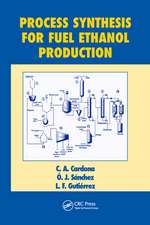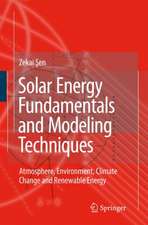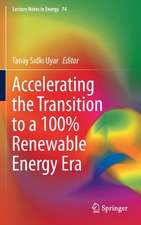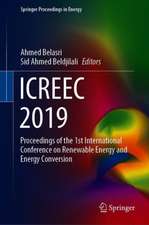Photovoltaic Sources: Modeling and Emulation: Green Energy and Technology
Autor Maria Carmela Di Piazza, Gianpaolo Vitaleen Limba Engleză Paperback – 9 noi 2014
The main benefit of reading Photovoltaic Sources is the ability to face the emulation of photovoltaic generators obtained by the design of a suitable equipment in which voltage and current are the same as in a real source. This is achieved according to the following steps: the source electrical behavior modeling, the power converter design, including its control, for the laboratory emulator. This approach allows the reader to cope with the creation of an indoor virtual photovoltaic plant, in which the environmental conditions can be imposed by the user, for testing real operation including maximum power point tracking, partial shading, control for the grid or load interfacing, etc.
Photovoltaic Sources is intended to meet the demands of postgraduate level students, and should prove useful to professional engineers and researchers dealing with the problems associated with modeling and emulation of photovoltaic sources.
| Toate formatele și edițiile | Preț | Express |
|---|---|---|
| Paperback (1) | 945.47 lei 6-8 săpt. | |
| SPRINGER LONDON – 9 noi 2014 | 945.47 lei 6-8 săpt. | |
| Hardback (1) | 950.52 lei 6-8 săpt. | |
| SPRINGER LONDON – 16 oct 2012 | 950.52 lei 6-8 săpt. |
Din seria Green Energy and Technology
- 18%
 Preț: 943.43 lei
Preț: 943.43 lei - 20%
 Preț: 629.52 lei
Preț: 629.52 lei - 18%
 Preț: 1124.92 lei
Preț: 1124.92 lei - 18%
 Preț: 947.35 lei
Preț: 947.35 lei - 15%
 Preț: 655.92 lei
Preț: 655.92 lei - 18%
 Preț: 957.62 lei
Preț: 957.62 lei - 18%
 Preț: 789.52 lei
Preț: 789.52 lei - 17%
 Preț: 464.55 lei
Preț: 464.55 lei - 15%
 Preț: 645.79 lei
Preț: 645.79 lei - 18%
 Preț: 903.93 lei
Preț: 903.93 lei - 24%
 Preț: 1322.07 lei
Preț: 1322.07 lei - 18%
 Preț: 890.54 lei
Preț: 890.54 lei - 18%
 Preț: 1115.46 lei
Preț: 1115.46 lei - 18%
 Preț: 1117.03 lei
Preț: 1117.03 lei - 18%
 Preț: 949.73 lei
Preț: 949.73 lei - 18%
 Preț: 892.11 lei
Preț: 892.11 lei - 15%
 Preț: 648.24 lei
Preț: 648.24 lei - 18%
 Preț: 997.09 lei
Preț: 997.09 lei - 15%
 Preț: 579.81 lei
Preț: 579.81 lei - 18%
 Preț: 1123.15 lei
Preț: 1123.15 lei - 18%
 Preț: 961.41 lei
Preț: 961.41 lei - 17%
 Preț: 490.22 lei
Preț: 490.22 lei - 18%
 Preț: 904.60 lei
Preț: 904.60 lei - 15%
 Preț: 643.34 lei
Preț: 643.34 lei -
 Preț: 287.90 lei
Preț: 287.90 lei - 24%
 Preț: 634.04 lei
Preț: 634.04 lei -
 Preț: 379.39 lei
Preț: 379.39 lei - 18%
 Preț: 783.20 lei
Preț: 783.20 lei - 18%
 Preț: 1394.84 lei
Preț: 1394.84 lei - 18%
 Preț: 1691.57 lei
Preț: 1691.57 lei - 18%
 Preț: 1112.48 lei
Preț: 1112.48 lei - 15%
 Preț: 592.61 lei
Preț: 592.61 lei - 18%
 Preț: 952.09 lei
Preț: 952.09 lei - 18%
 Preț: 944.19 lei
Preț: 944.19 lei - 18%
 Preț: 891.33 lei
Preț: 891.33 lei - 18%
 Preț: 1252.44 lei
Preț: 1252.44 lei - 18%
 Preț: 789.52 lei
Preț: 789.52 lei - 20%
 Preț: 566.29 lei
Preț: 566.29 lei - 18%
 Preț: 1113.71 lei
Preț: 1113.71 lei - 18%
 Preț: 1114.24 lei
Preț: 1114.24 lei - 24%
 Preț: 590.58 lei
Preț: 590.58 lei - 20%
 Preț: 567.49 lei
Preț: 567.49 lei - 24%
 Preț: 907.48 lei
Preț: 907.48 lei - 18%
 Preț: 952.89 lei
Preț: 952.89 lei - 18%
 Preț: 952.89 lei
Preț: 952.89 lei - 18%
 Preț: 950.52 lei
Preț: 950.52 lei
Preț: 945.47 lei
Preț vechi: 1153.02 lei
-18% Nou
Puncte Express: 1418
Preț estimativ în valută:
180.91€ • 189.40$ • 149.70£
180.91€ • 189.40$ • 149.70£
Carte tipărită la comandă
Livrare economică 05-19 aprilie
Preluare comenzi: 021 569.72.76
Specificații
ISBN-13: 9781447160144
ISBN-10: 1447160142
Pagini: 316
Ilustrații: XVII, 299 p.
Dimensiuni: 155 x 235 x 17 mm
Greutate: 0.45 kg
Ediția:2013
Editura: SPRINGER LONDON
Colecția Springer
Seria Green Energy and Technology
Locul publicării:London, United Kingdom
ISBN-10: 1447160142
Pagini: 316
Ilustrații: XVII, 299 p.
Dimensiuni: 155 x 235 x 17 mm
Greutate: 0.45 kg
Ediția:2013
Editura: SPRINGER LONDON
Colecția Springer
Seria Green Energy and Technology
Locul publicării:London, United Kingdom
Public țintă
ResearchCuprins
From Nuclear Fusion to the Radiated Energy on the Earth.- From Radiated Energy to Electric Energy: Physics of Photovoltaic Cell.- Photovoltaic Source Models.- Parameters Identification for Photovoltaic Source Models.- Photovoltaic Source Dynamic Modeling Issues.- Photovoltaic Source Emulation.- DC/DC Power Converters (for PV Source Emulation).- Control of the DC/DC converters for PV source emulation.
Notă biografică
Maria Carmela Di Piazza received her MS with honors and PhD from the University of Palermo, Italy, in 1997 and 2001, respectively, in Electrical Engineering. Between 1999 and 2000 she was a visiting scholar at the University of Nottingham, UK. Since 2001 she has been a permanent researcher with the National Research Council (CNR) at the Institute of Intelligent Systems for Automation (ISSIA). She has been a participant of several research programs on renewable energy sources, power electronics and electromagnetic compatibility and she is currently leading, within the CNR-ISSIA, a research project on new technologies for the electrical efficiency in smart grids and smart buildings, sponsored by Italian Ministry of Education (MIUR). She is the principal author and co-author of about 70 ISI journal and conference papers. She is a member of IEEE and she serves as reviewer for several journals and conferences. Her main research interests include electric power generation by renewable sources, power electronics and EMI issues in power converters and drives.
Gianpaolo Vitale received his MS with honors in Electronic Engineering from the University of Palermo, Italy in 1988. From 1994 to 2001 he has been a researcher and since 2002 he has been a senior researcher with the National Research Council (CNR) at the Institute of Intelligent Systems for Automation (ISSIA). He has been professor of Power Electronics and Applied Electronics at the Engineering Faculty of Palermo from 1999 to 2007. He has been the supervisor of a research project on electromagnetic compatibility of electric drives and of a research project on intelligent management of electric energy supplied by renewable sources. He is the principal author and co-author of about 100 ISI journal and conference papers. He is co-author of a book on power electronics and drives management by neural networks. He is a member of IEEE and he serves as reviewer for several journals and conferences. Hiscurrent research interests include power electronics, electric power generation by renewable sources and related problems of electromagnetic compatibility.
Gianpaolo Vitale received his MS with honors in Electronic Engineering from the University of Palermo, Italy in 1988. From 1994 to 2001 he has been a researcher and since 2002 he has been a senior researcher with the National Research Council (CNR) at the Institute of Intelligent Systems for Automation (ISSIA). He has been professor of Power Electronics and Applied Electronics at the Engineering Faculty of Palermo from 1999 to 2007. He has been the supervisor of a research project on electromagnetic compatibility of electric drives and of a research project on intelligent management of electric energy supplied by renewable sources. He is the principal author and co-author of about 100 ISI journal and conference papers. He is co-author of a book on power electronics and drives management by neural networks. He is a member of IEEE and he serves as reviewer for several journals and conferences. Hiscurrent research interests include power electronics, electric power generation by renewable sources and related problems of electromagnetic compatibility.
Textul de pe ultima copertă
Modeling of photovoltaic sources and their emulation by means of power electronic converters are challenging issues. The former is tied to the knowledge of the electrical behavior of the PV generator; the latter consists in its realization by a suitable power amplifier. This extensive introduction to the modeling of PV generators and their emulation by means of power electronic converters will aid in understanding and improving design and set up of new PV plants.
The main benefit of reading Photovoltaic Sources is the ability to face the emulation of photovoltaic generators obtained by the design of a suitable equipment in which voltage and current are the same as in a real source. This is achieved according to the following steps: the source electrical behavior modeling, the power converter design, including its control, for the laboratory emulator. This approach allows the reader to cope with the creation of an indoor virtual photovoltaic plant, in which the environmental conditions can be imposed by the user, for testing real operation including maximum power point tracking, partial shading, control for the grid or load interfacing, etc.
Photovoltaic Sources is intended to meet the demands of postgraduate level students, and should prove useful to professional engineers and researchers dealing with the problems associated with modeling and emulation of photovoltaic sources.
The main benefit of reading Photovoltaic Sources is the ability to face the emulation of photovoltaic generators obtained by the design of a suitable equipment in which voltage and current are the same as in a real source. This is achieved according to the following steps: the source electrical behavior modeling, the power converter design, including its control, for the laboratory emulator. This approach allows the reader to cope with the creation of an indoor virtual photovoltaic plant, in which the environmental conditions can be imposed by the user, for testing real operation including maximum power point tracking, partial shading, control for the grid or load interfacing, etc.
Photovoltaic Sources is intended to meet the demands of postgraduate level students, and should prove useful to professional engineers and researchers dealing with the problems associated with modeling and emulation of photovoltaic sources.
Caracteristici
Includes numerous illustrations Enables the reader to emulate photovoltaic generators Allows the reader to test maximum power point tracking techniques Includes supplementary material: sn.pub/extras

